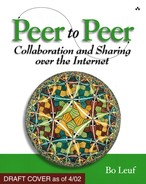Peer Integration
Any really pervasive technology sooner or later integrates into the very fabric of our lives until we no longer really see it. A time-travel visitor from a century or two ago (in some cases, only decades ago), would marvel at some of the profound revolutions that we take for granted, even when they have drastically transformed our everyday environment. To gain some appreciation of this, it’s enough to just look at some decades-old film and consciously enumerate all the things that are totally missing.
Some of these now-pervasive technologies have already been mentioned: telephony and the cellular handset, or the Internet and its services (Web and e-mail). Others have more been implied: the PC revolution, or computers at all for that matter, consumer electronics and always-available media (such as CD, tape, radio, TV), mass published books and magazines, mass transportation and its associated infrastructure (highways, service stations, the oil economy; suburbs, malls, and acres of parking lots; airports, let’s not forget airports), and so on.
Harder to see are the social and lifestyle changes. Take, for example, shifts due to the year-round selection of produce culled from near and far in our supermarkets, or to the way people casually travel great distances for short vacations or make global business trips lasting only days.
It’s more than likely that a few decades hence, the viewer of a film made today would be able to enumerate a large number of very basic things that are missing in that picture, a fair number of which would be directly or indirectly a result of the widespread deployment of p2p technologies and associated services. Many of these services would naturally have to do with communication in one form or another, yet for others, it might be very difficult to directly see this connection.
An off-the-cuff example: One can actually identify changes in how homes are both built and furnished that in one way or another reflect the central role that home entertainment electronics has come to play over the decades. It seems likely that integrated p2p could have similar far-reaching effects of at least the same magnitude, especially if it profoundly changes our work habits. Already, many people remote-work from home at least part of the time and hence have office space in their homes.
Major technology initiatives such as Internet2 have the stated goal of integrating the next-generation high bandwidth services with schools and business, something that will assuredly have great transformative effects there. The building blocks are visible to a great extent in the implementations that are covered in this book, as are the immediate uses, but it would be a difficult task to say with any degree of confidence what usage patterns we would see in only a decade or two.
Integration with the New Web
New Web services technologies are being deployed that allow Internet applications to communicate with each other in advanced ways. Microsoft’s .NET and Sun’s SunONE are the two main contenders at present.
In themselves based on many p2p concepts, either one can provide infrastructure options for new p2p technologies to develop. Interoperable XML-based protocols such as SOAP allow applications to expose local services to each another over the Web. New standards provide a feature-rich environment for managing such services—for instance, Web Services Description Language (WSDL) and Universal Description, Discovery and Integration (UDDI), along with a large number of collaborative possibilities. Others are more directly business oriented, such as Organization for the Advancement of Structured Information Standards (OASIS) and Business Process Modeling Language (BPML).
Other emerging specifications concern interoperability among autonomous systems, which were hinted at in the agency component summary for p2p implementations introduced in Chapter 2. The Foundation for Intelligent Physical Agents (FIPA, www.fipa.org) is one body that might play a pivotal role in this development by providing definitions of standards for common semantics for agent interaction, cooperation and coordination. One goal is to define complex tasks in a common way so that they can be distributed among multiple peers for execution. Another goal is to implement intelligent directory services, likely distributed as well, that will allow agents to locate and query available peers and other Web services.
FIPA’s main emphasis is on practical commercial and industrial uses of agent systems. The development of intelligent or cognitive agents however is, as the name suggests, a long-term goal. This goal is perhaps unreachable, but no less noble—software systems that have the potential for reasoning about themselves and their environment. I, for one, suspect we have a long way to go before then. AI has been described as being “almost here” as much and as long as commercial fusion power. Yet decades of “not quite there” suggest that something fundamental is missing or wrong in the assumptions that the practical technology is trying to build on.
Having reached the edge of current development several times throughout this text, and ventured into future speculation more than once, perhaps it’s now time to take that last step and wander freely into the visions, rosy or dark, that await us.
